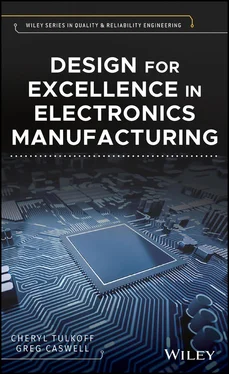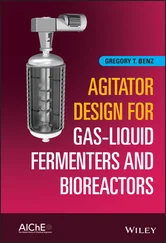Cheryl Tulkoff - Design for Excellence in Electronics Manufacturing
Здесь есть возможность читать онлайн «Cheryl Tulkoff - Design for Excellence in Electronics Manufacturing» — ознакомительный отрывок электронной книги совершенно бесплатно, а после прочтения отрывка купить полную версию. В некоторых случаях можно слушать аудио, скачать через торрент в формате fb2 и присутствует краткое содержание. Жанр: unrecognised, на английском языке. Описание произведения, (предисловие) а так же отзывы посетителей доступны на портале библиотеки ЛибКат.
- Название:Design for Excellence in Electronics Manufacturing
- Автор:
- Жанр:
- Год:неизвестен
- ISBN:нет данных
- Рейтинг книги:5 / 5. Голосов: 1
-
Избранное:Добавить в избранное
- Отзывы:
-
Ваша оценка:
- 100
- 1
- 2
- 3
- 4
- 5
Design for Excellence in Electronics Manufacturing: краткое содержание, описание и аннотация
Предлагаем к чтению аннотацию, описание, краткое содержание или предисловие (зависит от того, что написал сам автор книги «Design for Excellence in Electronics Manufacturing»). Если вы не нашли необходимую информацию о книге — напишите в комментариях, мы постараемся отыскать её.
By employing the concepts outlined in
engineers and managers can increase customer satisfaction, market share, and long-term profits. In addition, the authors describe the best practices regarding product design and show how the practices can be adapted for different manufacturing processes, suppliers, use environments, and reliability expectations. This important book:
Contains a comprehensive review of the design and reliability of electronics Covers a range of topics: establishing a reliability program, design for the use environment, design for manufacturability, and more Includes technical information on electronic packaging, discrete components, and assembly processes Shows how aspects of electronics can fail under different environmental stresses Written for reliability engineers, electronics engineers, design engineers, component engineers, and others,
is a comprehensive book that reveals how to get product design right the first time.
Design for Excellence in Electronics Manufacturing — читать онлайн ознакомительный отрывок
Ниже представлен текст книги, разбитый по страницам. Система сохранения места последней прочитанной страницы, позволяет с удобством читать онлайн бесплатно книгу «Design for Excellence in Electronics Manufacturing», без необходимости каждый раз заново искать на чём Вы остановились. Поставьте закладку, и сможете в любой момент перейти на страницу, на которой закончили чтение.
Интервал:
Закладка:
Library of Congress Cataloging‐in‐Publication Data
Names: Tulkoff, Cheryl, author. | Caswell, Greg, author.
Title: Design for excellence in electronics manufacturing / Cheryl Tulkoff,
US, Greg Caswell, US.
Description: Hoboken, NJ : Wiley, 2021. | Series: Quality and reliability
engineering series | Includes bibliographical references and index.
Identifiers: LCCN 2020027863 (print) | LCCN 2020027864 (ebook) | ISBN
9781119109372 (cloth) | ISBN 9781119109389 (adobe pdf) | ISBN
9781119109396 (epub)
Subjects: LCSH: Electronic apparatus and appliances–Design and
construction.
Classification: LCC TK7870 .T845 2021 (print) | LCC TK7870 (ebook) | DDC
621.381–dc23
LC record available at https://lccn.loc.gov/2020027863
LC ebook record available at https://lccn.loc.gov/2020027864
Cover Design: Wiley
Cover Image: © graphicINmotion/Shutterstock
I would like to dedicate this book to my wife, June, who was there for me during the entire book-writing process. Thanks my love.G.C.I’d like to dedicate this book to my husband, Mike, and my son, David, for their patience and understanding through the long, cranky hours spent writing and rewriting.C.A.T.
Series Editor's Foreword by Dr. Andre Kleyner
The Wiley Series in Quality & Reliability Engineering was launched 25 years ago. Since then, it has grown into a valuable source of theoretical and practical knowledge in the field of quality and reliability engineering, continuously evolving and expanding to include the latest developments in these disciplines.
Each year, engineering systems are becoming more complex, with new functions and capabilities and longer expected service lives; however, the reliability requirements remain the same or become more stringent due to the increasing expectations of product end users. With the rapid development of autonomous vehicles and growing attention to functional safety, these expectations have grown even further. It will require the utmost reliability to convince people to entrust their lives to an “inhuman machine”; only by using new visions, methods, and approaches to develop engineering systems – and electronic systems in particular – will this become a reality.
The book you are about to read was written by experts in the field of electronics design and manufacturing. Cheryl Tulkoff and Greg Caswell, whom I have the privilege to know personally, have a depth and variety of experiences covering virtually every aspect of design for reliability and quality manufacturing of electronics. This book presents an easy‐to‐read, step‐by‐step guide to designing, testing, validating, and building highly reliable electronic systems. It also addresses sustainability and obsolescence – the flip side of fast IC evolution and miniaturization – which are significant issues for electronic systems designed to operate for long periods, such as those in fields such as automotive, airspace, defense, etc.
Despite its obvious importance, quality and reliability education is paradoxically lacking in today's engineering curriculum. Few engineering schools offer degree programs or even a sufficient variety of courses in quality and reliability methods. Therefore, most quality and reliability practitioners receive their professional training from colleagues, engineering seminars, publications, and technical books. The lack of formal education opportunities in this field highlights the importance of technical publications such as this one for professional development.
We are confident that this book, as well as the entire series, will continue Wiley's tradition of excellence in technical publishing and provide a lasting and positive contribution to the teaching and practice of engineering.
Foreword
First and foremost, this book is an invaluable technical gem – front‐line experience pours out of it to those (like me) who are listening. This is a work as spoken, not as written or read, from a voice who has seen and knows electronics design, manufacturing, and reliability from the beginning looking forward and the end looking back; and who has gained knowledge from experience, intelligence, and maybe even a few mistakes. Those are laymen's terms for the complex and critical technical and commonsense details that distinguish Designing for Excellence in Manufacturing from the more common “Design it and throw it over the wall to manufacturing” approaches.
Ken Symonds
Technologist
Western Digital Corporation
Preface
With our combined 80+ years of experience in electronics manufacturing encompassing integrated circuit fabrication, printed circuit board fabrication, circuit board assembly, and work in materials, packaging, processes, and standards, we feel uniquely qualified and privileged to author this book.
Our inspiration to write it came from peers, clients, and students in the electronics industry. Through our work with them, we realized we were answering the same questions, solving the same problems, and seeing the industry make the same mistakes over and over. We found that both unfortunate and discouraging. We were unable to find a comprehensive how‐to guide and felt we had a unique opportunity to help prevent problems from recurring.
We wrote this book for electronics design, manufacturing, and reliability engineers and those who work with them. We wanted to create a practical guide containing tools, tips, and solutions to help engineers create high‐quality, high‐reliability products. We sincerely hope we have succeeded.
April 2021
Cheryl Tulkoff and Greg Caswell
Austin, Texas, USA
Acknowledgments
The authors would like to thank the engineering teams at Ansys‐DfR Solutions and National Instruments for their support during the development of this book. We would particularly like to thank Dr. Craig Hillman, Dr. Nathan Blattau, Jim McLeish, Dr. Randy Schueller, and Seth Binfield for exceptional technical input in their areas of expertise. Their contributions made the book a more comprehensive resource.
We would like to recognize Ken Symonds for performing a detailed review of the entire book and offering numerous editorial comments that significantly enhanced it. His input on grammar and complexity also made the book infinitely more readable.
Andre Kleyner provided the critical initial nudge and persistent support in driving us to make the book a reality. Ella Mitchell at Wiley secured the technical reviews for us at the concept stage and made sure all of the important paperwork got done.
We'd like to express our gratitude to our peers and students from the electronics industry organizations that we have taught and volunteered for over the years, including IPC, SMTA, iMAPS, IEEE, and ASQ. Their questions, feedback, and knowledge have greatly informed this book.
Finally, we would like to thank our respective companies and families for giving us the time to bring the entire manuscript together. We hope you find it useful.
Cheryl Tulkoff and Greg Caswell
Acronyms
2Dtwo‐dimensional3Dthree‐dimensionalAABUSas agreed between user and supplierACalternating currentADAautomated design analysisAFacceleration factorAFSCAir Force Systems CommandAgsilverALTaccelerated life testAMRabsolute maximum ratingANSIAmerican National Standards InstituteAOIautomated optical inspectionASTMAmerican Society for Testing and MaterialAVLapproved vendor listBGAball grid arrayBISTbuilt in self‐testBOMbill of materialsBTCbottom termination componentCcentigradeC0Gtemperature‐stable dielectricCADcomputer‐aided designCAFconductive anodic filamentCAMcomputer‐aided manufacturingCAPEXcomponent cost and installation expenseCARcorrective action requestCBGAceramic ball grid arrayCCAcircuit card assemblyCDMcharged device modelCFFconductive filament formationCIcontinuous improvementcmcentimeterCMcontract manufacturerCMOScomplementary metal oxide semiconductorCOBchip on boardCOPcomputer operating properlyCOTScommercial off the shelfCPUcentral processing unitC‐SAMC‐mode scanning acoustic microscopyCSPchip‐scale packageCTEcoefficient of thermal expansionCTQcritical to qualityCTScompatibility test suiteCucopperCVDchemical vapor depositionDCdirect currentDfMDesign for ManufacturabilityDFMEAdesign failure modes and effects analysisDfRDesign for ReliabilityDfSDesign for SustainabilityDfTDesign for TestDfXDesign for ExcellenceDIdeionizedDICdigital image correlationDIPdual inline packageDMAdimethylacetamide; dynamic mechanical analysisDMFdimethylformamideDMSMSdiminishing manufacturing sources and material shortagesDoDUS Department of DefenseDPMOdefects per million opportunitiesDRAMdynamic random access memoryDRBdata‐retention bakeDRBFMdesign review by failure modeDRCdesign rule checkDSCdifferential scanning calorimetryDUTdevice under testEaactivation energyEAengineering authorityEBICelectron beam induced currentECMelectrochemical migrationECNengineering change noticeEDAelectronic design automationEDRelectronics design reliabilityEDXenergy dispersive X‐ray spectroscopyEEEelectrical, electronic, electromechanicalEFATextended factory acceptance testEMelectromigrationEMCelectromagnetic compatibilityEMIelectromagnetic interferenceEMSelectronic manufacturing servicesENDendurance testENEPIGelectroless nickel / electroless palladium / immersion goldENIGelectroless nickel / immersion goldEOLend of lifeEOSelectrical overstressEPDMethylene propylene diene monomerERCelectrical rule checkESDelectrostatic dischargeESRequivalent series resistanceESSelectrical stress screening; environmental stress screeningeVelectron voltsF3form, fit, and functionFAfailure analysisFARFederal Acquisition RegulationsFATfactory acceptance testFEAfinite element analysisFETfield effect transistorFIBfocused ion beamFIFOfirst in, first outFITfailures in timeFMEAfailure modes and effects analysisFMECAfailure modes, effects, and criticality analysisFR4fire retardant 4FRACASFailure Reporting, Analysis, and Corrective Action SystemFTAfault‐tree analysisFTIRFourier transform infrared spectroscopyGBLy‐butyrolactoneGEIAGovernment Electronics and Information Technology AssociationGHzgigahertzGNDgroundGrmsgravity root mean squareHALThighly accelerated life testingHASAhighly accelerated stress auditHASLhot air solder levelingHASShighly accelerated stress screening;HASThighly accelerated stress test; highly accelerated stress testingHATShighly accelerated thermal shockHBMhuman body modelHCFhigh cycle fatigueHCIhot carrier injectionHDDhard disk driveHDIhigh‐density interconnectHPLChigh‐performance liquid chromatographyHTOLhigh‐temperature operating lifeI/Oinput/outputICintegrated circuitICTin‐circuit test; ion chromatography testingIDidentificationIDMintegrated device manufacturerIECInternational Electrotechnical CommissionIEEEInstitute of Electrical and Electronics EngineersImAgimmersion silverIMCintermetallic growthImSnimmersion tinIPCassociation connecting electronics industriesIRinfraredISOInternational Organization for StandardizationISTintegrated system testJEDECJoint Electronic Devices Engineering CouncilJPLJet Propulsion LaboratoryJTAGJoint Task Action GroupKClpotassium chlorideKPIkey performance indicatorLCCCleadless ceramic chip carrierLCDliquid crystal displayLCFlow cycle fatigueLCRinductance‐capacitance‐resistanceLEDlight‐emitting diodeLFlead‐freeLGAland‐grid arrayLPIliquid photo imageableLTSlong‐term storageLUlatch upMBBmoisture barrier bagMCMmulti‐chip modulesMCM‐Lmulti‐chip module ‐ laminateMEMSmicro‐electro‐mechanical systemMFGmixed flowing gasMHzmegahertzMILmilitaryMIL‐HDBKmilitary handbookMIL‐SPECmilitary specificationMLCCmulti‐layer ceramic capacitormmmillimeterMMmachine modelMnO2manganese dioxideMRP/ERPmaterials requirements planning/enterprise resource planningMSLmoisture sensitivity levelMSPmanaged supply programMTBFmean time between failuresMTTFmean time to failureNaClsodium chlorideNASANational Aeronautics and Space AdministrationNAVSEANaval Sea Systems CommandNBTInegative bias temperature instabilityNDEnon‐destructive evaluationsNISTNational Institute of StandardsnmnanometerNPInew product introductionNREnon‐recurring expenseNSMDnon‐soldermask definedNTFno trouble foundOBICoptical beam induced currentODMoriginal design manufacturerOEMoriginal equipment manufacturerOPEXoperation/maintenance/intervention expenseORTongoing reliability test; ongoing reliability testingOSPorganic solderability preservativePbleadPCpersonal computerPCBprinted circuit boardPCBAprinted circuit board assemblyPCMCIAPersonal Computer Memory Card International AssociationPCNprocess change noticePCQR2printed board capability, quality, and relative reliabilityPESDpolymer electro‐static discharge devicePFMEAprocess failure modes and effects analysisPGApin‐grid arraypKaacid disassociation constantPLLphase‐locked loopPoFphysics of failurePoPpackage on packageppbparts per billionppmparts per millionPSDpower spectral densityPTHplated through‐holePWBprinted wiring boardPWRpowerQBRquarterly business reviewQCIqualification conformance inspectionQFDquality functional deployment (house of quality)QFNquad flat‐pack no‐leadsQFPquad flat‐packRADCRome Air Development CenterRCARadio Corporation of AmericaRDTreliability demonstration testingREACHRegistration, Evaluation, Authorization and Restriction of Chemical SubstancesRFradio frequencyRGTreliability growth testRHrelative humidityRIACReliability Information Analysis CenterRMArosin, mildly activatedROrosin onlyROCrecommended operating conditionsRoHSRestriction of the Use of Certain Hazardous Substances in Electrical and Electronic EquipmentROIreturn on investmentROL0rosin low, flux type L0ROL1rosin low, flux type L1ROSEresistivity of solvent extractRPAreliability physics analysisSACtin/silver/copper (Sn/Ag/Cu)SAC305tin silver copper 305SAESociety of Automotive EngineersSAMscanning acoustic microscopySCARsupplier corrective action requestSEMscanning electron microscopeSEUsingle‐event upsetSIGsignalSILsafety integrity levelSIMSsecondary ion mass spectroscopySiO2silicon dioxideSiPsystem in packageSIRsurface insulation resistanceSITsystem integration testSMDsurface‐mounted deviceSMTsurface‐mount technologySnPbtin leadSoCsystem on a chipSOHstate of healthSPCstatistical process controlSPPsteam pressure potSQUIDsuperconducting quantum interfering device microscopyTaambient temperatureTAtechnical authorityTALtime above liquidusTAPtest access pointsTBDto be determinedTccase temperatureTCtemperature cycle; thermal cyclingTddecomposition temperatureTDDBtime‐dependent dielectric breakdownTDRtime domain reflectometryTgglass transition temperatureTHBtemp, humidity, and biasTIDtotal ionizing doseTIMthermal interface materialTjjunction temperatureTMAthermo‐mechanical analysisTMFthermo‐mechanical failureTOFtime of flightTRAPtechnical risk assurance processTsheat sink temperatureTSLtemperature sensitivity levelTSOPthin small‐outline packageTTFtime to failureTVtelevisionμgmicrogramUHFultra‐high frequencyULUnderwriter LaboratoriesUPSuninterruptible power supplyUUTunit under testUVultravioletVvoltVACvolts alternating currentVCCIC voltage pinVDRvoltage‐dependent resistorsVdsvoltage drain to sourceVIPvia in padWwattWEEEwaste electrical and electronic equipmentWOAweak organic acidX7Rtemperature‐stable dielectric
Читать дальшеИнтервал:
Закладка:
Похожие книги на «Design for Excellence in Electronics Manufacturing»
Представляем Вашему вниманию похожие книги на «Design for Excellence in Electronics Manufacturing» списком для выбора. Мы отобрали схожую по названию и смыслу литературу в надежде предоставить читателям больше вариантов отыскать новые, интересные, ещё непрочитанные произведения.
Обсуждение, отзывы о книге «Design for Excellence in Electronics Manufacturing» и просто собственные мнения читателей. Оставьте ваши комментарии, напишите, что Вы думаете о произведении, его смысле или главных героях. Укажите что конкретно понравилось, а что нет, и почему Вы так считаете.












